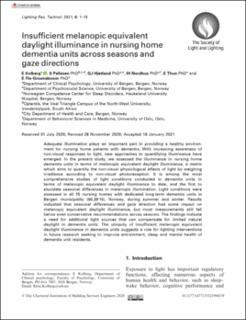Insufficient melanopic equivalent daylight illuminance in nursing home dementia units across seasons and gaze directions
Kolberg, Eirin; Pallesen, Ståle; Hjetland, Gunnhild Johnsen; Nordhus, Inger Hilde; Thun, Eirunn; Flo-Groeneboom, Elisabeth
Journal article, Peer reviewed
Published version

Åpne
Permanent lenke
https://hdl.handle.net/11250/2838923Utgivelsesdato
2022Metadata
Vis full innførselSamlinger
- Department of Clinical Psychology [234]
- Registrations from Cristin [10412]
Sammendrag
Adequate illumination plays an important part in providing a healthy environment for nursing home patients with dementia. With increasing awareness of non-visual responses to light, new approaches to quantifying illuminance have emerged. In the present study, we assessed the illuminance in nursing home dementia units in terms of melanopic equivalent daylight illuminance, a metric which aims to quantify the non-visual physiological effects of light by weighing irradiance according to non-visual photoreception. It is among the most comprehensive studies of light conditions conducted in dementia units in terms of melanopic equivalent daylight illuminance to date, and the first to elucidate seasonal differences in melanopic illumination. Light conditions were assessed in all 15 nursing homes with dedicated long-term dementia units in Bergen municipality (60.39°N), Norway, during summer and winter. Results indicated that seasonal differences and gaze direction had some impact on melanopic equivalent daylight illuminance, but most measurements still fell below even conservative recommendations across seasons. The findings indicate a need for additional light sources that can compensate for limited natural daylight in dementia units. The ubiquity of insufficient melanopic equivalent daylight illuminance in dementia units suggests a role for lighting interventions in future research seeking to improve entrainment, sleep and mental health of dementia unit residents.
